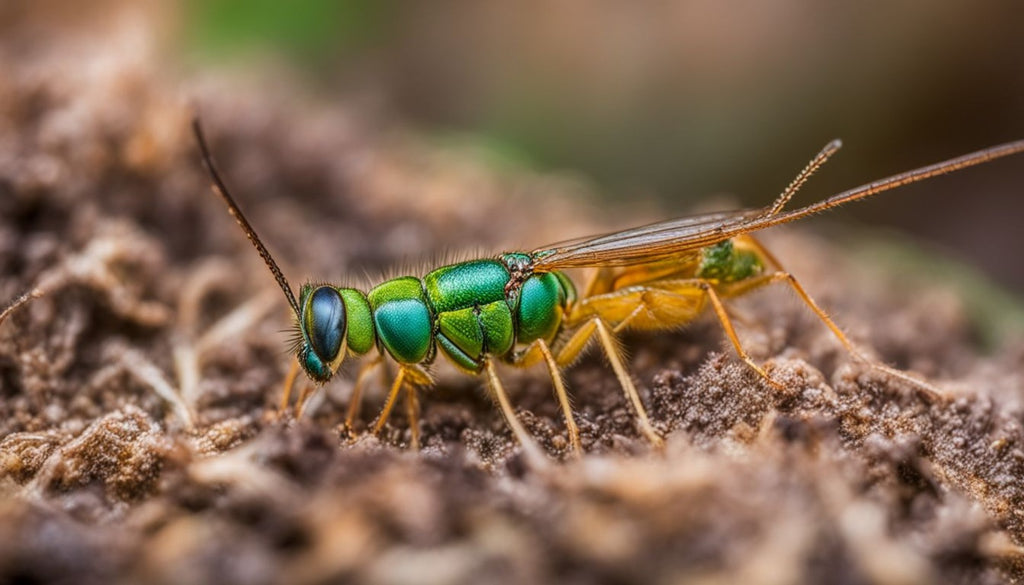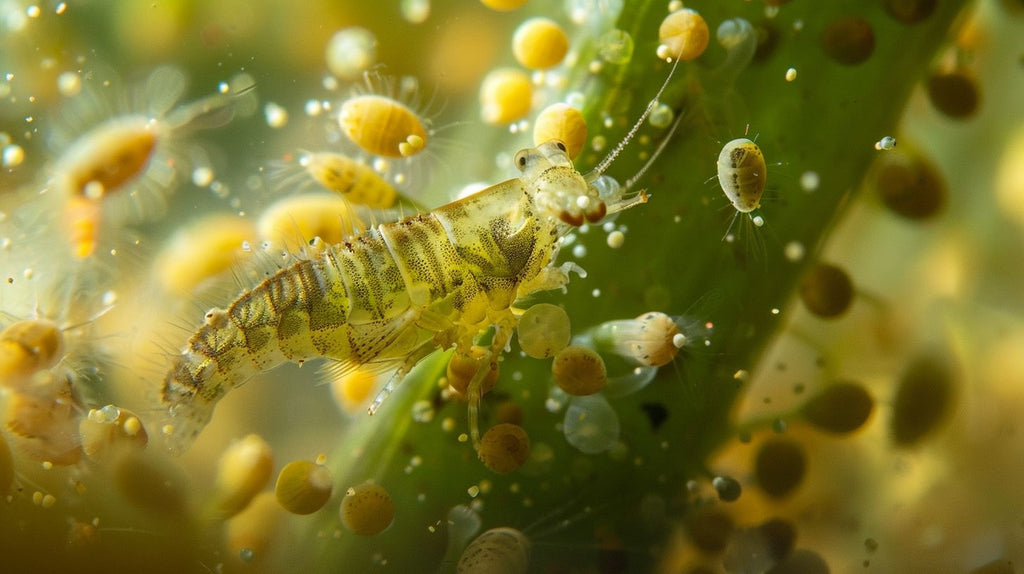The Power Of Stratiolaelaps Scimitus: Your Guide To Controlling Fungus Gnats And Shore Flies
Discover the natural power of Stratiolaelaps scimitus, a tiny but mighty warrior in the fight against pesky fungus gnats and shore flies. This predatory mite works undercover in the soil and plant substrates, offering a green and efficient solution to pest problems that plague gardens and greenhouses.
With insights on how to boost plant health, minimize damage from these common pests, and embrace sustainable gardening practices, this guide is your go-to resource for making the most of Stratiolaelaps scimitus in your growing spaces.
Perfect for both seasoned growers and gardening newbies, it's packed with practical advice to help you grow healthier plants by leveraging the natural pest-fighting abilities of these incredible mites.
Understanding Stratiolaelaps Scimitus

Stratiolaelaps scimitus, also known as hypoaspis miles, is a tiny but mighty predator mite. It thrives in the soil and hunts down pests like fungus gnat larvae, thrips pupae, and springtails.
These mites love to eat harmful insects that attack plants’ roots. This makes them great allies for growers who want healthy crops without using chemical pesticides.
Growers release these beneficial insects into their soil at different rates depending on the pest problem. For a standard issue, they might spread 5-10 mites per square foot. But if there's a heavy infestation, they could need 30+ mites per square foot to tackle it.
Keeping Stratiolaelaps scimitus before use is easy too; just store them in a cool, dark place away from direct sunlight. With all these traits combined, Stratiolaelaps scimitus stands out as an effective biological control agent against several key pest species in agriculture.
Read More: How To Get Rid Of Pill Bugs
How to Utilize Stratiolaelaps Scimitus for Pest Control

To control pests, release Stratiolaelaps Scimitus directly into your soil or plant pots, where they hunt down harmful bugs.
Ideal Conditions for Stratiolaelaps Scimitus
Stratiolaelaps scimitus thrives in specific conditions. They do best at temperatures ranging from 60-74°F and require high relative humidity to flourish. These mites also prefer moist soil for their activities but cannot survive in areas with standing water.
For growers, maintaining these conditions means Stratiolaelaps scimitus can effectively hunt down pests like fungus gnats, shoreflies, and root aphids.
Moisture levels are critical for the success of using Stratiolaelaps scimitus as a natural predator in pest control efforts. Ensuring the soil stays moist without becoming waterlogged creates an ideal environment for these beneficial nematodes to reproduce and attack various insect pests throughout their lifecycle.
This balance supports a healthy ecosystem that allows Stratiolaelaps scimitus to protect crops from damaging bugs naturally.
Read More: How To Get Rid of Earwigs on Plants
Application Techniques
Using Stratiolaelaps scimitus for pest control is straightforward and effective. These mites target pests like fungus gnats and shore flies, breaking their lifecycle and reducing your crop's pest pressure. Here’s how to apply them correctly:
- Determine the application rate. For general pest control, use 5 - 10 mites per square foot. In cases of heavy infestation, increase this to 30+ mites per square foot.
- Choose your method of release. You can mix the mites into potting soil or sprinkle them directly onto the soil surface, where they will find and consume pests.
- Prepare the area before release. Make sure your crops are well watered but not overly damp to create ideal conditions for the mites to thrive.
- Release the mites immediately upon arrival. They ship mixed with adults and immature stages, ensuring a quick start in controlling pests.
- Store any unused mites properly, if not all are used at once. Keep them in a cool, dark place, but avoid refrigeration to maintain their effectiveness.
- Time your applications with your crop cycle in mind. Releasing Stratiolaelaps scimitus early in the season can prevent potential outbreaks by targeting pests before they become a significant problem.
The Role of Stratiolaelaps Scimitus in Pest Control

Stratiolaelaps scimitus hunts down harmful pests in soil. It keeps plants healthy by eating critters like fungus gnats and shore flies.
Effective Against Fungus Gnats
Fungus gnats are small, but they cause big problems for plants by eating their roots. Stratiolaelaps scimitus hunts down and eats the larvae of these pests in the soil, stopping them before they can harm your crops. This makes these predatory mites a key player in keeping your plants healthy.
Growers should release 5-10 mites per square foot to manage regular pest levels. For serious problems, increase this to over 30 mites per square foot. The predators come mixed with adults and immature stages.
You'll get the best results if you use them right away. This approach helps control fungus gnats effectively without harming the environment or beneficial insects like bees.
Combatant Against Shore Flies
Stratiolaelaps scimitus also shows great promise in managing shore flies. These pests thrive in moist soil conditions, causing harm to various crops.
By releasing Stratiolaelaps scimitus directly into the soil, growers can target shore flies effectively. The mites search for and consume the pests, including their larvae stages hidden in the soil.
Release rates are crucial for optimal control. For general pest management, applying 5-10 mites per square foot works well. However, in cases of heavy infestation, increasing the release rate to over 30 mites per square foot ensures better coverage and control.
Growers have seen significant reductions in shore fly populations by adhering to these guidelines, making Stratiolaelaps scimitus a trusted ally in biological pest control efforts.
The Lifecycle and Reproduction of Stratiolaelaps Scimitus
Stratiolaelaps scimitus goes through its life cycle in about 13 days. This swift development happens best between 60-74°F with plenty of moisture around. They start as eggs, then turn into hungry larvae that feed on pests.
These larvae grow into nymphs, which later mature into adults ready to hunt down fungi gnats, shore flies, and other target pests.
These mites reproduce quickly under the right conditions, laying more eggs to start the cycle over again. They don't need a mate to produce these eggs; they do it all by themselves.
When released into soil or on plants, they get right to work controlling pest populations naturally and effectively. Growers find this trait very beneficial for keeping their crops safe without using harmful chemicals.
Read More: White Flies: How To Prevent and Get Rid Of Them
Benefits of Using Stratiolaelaps Scimitus

Using Stratiolaelaps Scimitus offers a safe and effective way to protect your plants from pests, saving you time and money.
Environmentally Friendly
Stratiolaelaps Scimitus offers a green solution for growers looking to fight pest problems. It's an all-natural, chemical-free way to deal with grain mites and keep gardens thriving. Using these mites means you are taking a step towards organic farming, which is better for our planet.
They don't just control pests; they do it without harming the environment. This bio-control method reduces the need for harmful pesticides. Growers can maintain healthy soil and protect beneficial insects, making Stratiolaelaps Scimitus a top choice for eco-friendly pest management.
Long-lasting Solution
Using Stratiolaelaps scimitus offers a durable way to fight off pests like fungus gnats and shore flies. This method serves as a preventative control, keeping your plants safe for longer periods.
Since these mites reproduce quickly, they continue to protect your crops without needing frequent reapplication. They work well in various conditions, though it's important not to release them in lime-treated soils.
They prove more effective than many chemical options because their impact lasts long after their initial release. As growers, choosing Stratiolaelaps scimitus means investing in an ongoing guard against future infestations of unwanted insects.
Cost-effective
Stratiolaelaps scimitus saves you money in the battle against pests. You can choose different release rates, making it easy to control costs whether you're dealing with a big problem or just doing regular maintenance.
This predator attacks fungus gnat larvae, thrips pupae, and springtails right where they live—in the soil. By incorporating mites at potting or sprinkling them on the surface, growers find an affordable way to apply these beneficial insects.
Keeping Stratiolaelaps scimitus doesn't break the bank either. Store them in a cool, dark place away from sunlight to extend their life, maximizing your investment over a 13-day life cycle that ensures long-term pest defense.
Key Takeaways
- Stratiolaelaps scimitus is a mighty mite that eats harmful pests like fungus gnats and shore flies. It works well in soil, attacking the bad bugs before they damage plants.
- You can release these helpful mites into your garden or greenhouse by sprinkling them on the soil. For a standard problem, use 5-10 mites per square foot. If you have lots of pests, you might need over 30 mites per square foot.
- Keeping Stratiolaelaps scimitus is easy - just store them in a cool and dark place, but don't put them in the fridge. They are ready to fight pests right when they arrive at your place.
- Using Stratiolaelaps scimitus is good for the planet because it's a natural way to control pests without chemicals. This method doesn't harm other important insects or the environment.
- Choosing Stratiolaelaps scimitus as your pest control solution saves money over time. It helps keep your plants safe from bugs without needing to buy chemical sprays often. Plus, these mites keep working long after their first release by quickly making more eggs to start their cycle again.
Conclusion
Discover the might of Stratiolaelaps scimitus in battling pesky fungus gnats and shore flies. This guide equips growers with knowledge to deploy these beneficial mites effectively. Embrace environmentally friendly solutions that promise lasting results and cost savings.
For all your needs to kickstart this eco-friendly pest control method, Canada Grow Supplies is here to assist. We offer a wide range of products tailored to enhance your gardening success. Contact us for more details, and explore our blog for insights on integrating beneficial organisms like Stratiolaelaps scimitus into your gardening strategy.
With Canada Grow Supplies, you're one step closer to achieving a healthy, thriving garden free of unwanted pests.
FAQs
How does Stratiolaelaps Scimitus control pests?
This mighty mite attacks pests like the western flower thrips and sciarids by targeting their pupal stages, reducing their numbers in your garden.
Can Stratiolaelaps Scimitus help with all kinds of plant pests?
While it's great against certain pests, it doesn't target parasites such as Riccardoella limacum or parasitic nematodes but can manage mealybugs effectively.
Is Stratiolaelaps Scimitus safe for all plants?
Yes! It’s beneficial for various plants, from strawberries to cactuses, helping protect them without harming the plants themselves.
Does Stratiolaelaps Scimitus only work during growing seasons?
Nope! This predator can adapt through diapause to remain effective even when conditions aren’t ideal for growth, ensuring year-round protection for your plants.




